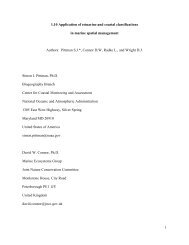Seamounts, Ridges, and Reef Habitats of American Samoa
Seamounts, Ridges, and Reef Habitats of American Samoa
Seamounts, Ridges, and Reef Habitats of American Samoa
- No tags were found...
Create successful ePaper yourself
Turn your PDF publications into a flip-book with our unique Google optimized e-Paper software.
796Seafloor Geomorphology as Benthic Habitatf0020Figure 58.3 Detailed bathymetry <strong>of</strong> Tutuila Isl<strong>and</strong>, based on the 200 m multibeam bathymetry<strong>of</strong> Figure 58.1, as well as available nearshore multibeam bathymetry at 2–5 m resolution.The morphology <strong>of</strong> Tutuila exhibits several highly incised secondary rift zones radiatingaway from the primary trend, a primary one <strong>of</strong> which extends from the northeastern corner <strong>of</strong>the isl<strong>and</strong> in a 30° trend (dashed line). The linear nature <strong>of</strong> these features implies structuralguidance <strong>of</strong> volcanism by fault or fracture zone.p0085to sea level. It likely breached in the past <strong>and</strong> has since been eroded by wave actionto produce a flat summit surface. South Bank has two perpendicular rifting zonestrending nearly in line with the four cardinal directions (Figure 58.4). Though it isprobably at least 1 million years old [1], its northern <strong>and</strong> southwestern flanks showrelatively little evidence <strong>of</strong> slope failure <strong>and</strong> are superimposed with small seamounts.It possesses an emerging stellate morphology, though it is not nearly as developed ason Tutuila or Northeast Bank. The shield-building stage for South Bank is not easilyattributable to a plume source, based on its divergent location <strong>and</strong> anomalous primaryrift trending at N0°E, though Hart et al. [1] suggest that decompressional meltingdue to slab–plume interactions could account for the location <strong>of</strong> South Bank.Northeast Bank: Northeast Bank (renamed “Muli” by Hart et al. [1]) is the secondlargest isolated edifice in the ESVP. It is partially connected to the Ofu-Olosegacomplex by a deep saddle <strong>and</strong> exhibits a near-stellate morphology, a testament toits highly eroded state <strong>and</strong> once circular shape (Figure 58.5). Its flat summit lieswithin 100 m <strong>of</strong> sea level <strong>and</strong> therefore we speculate that, like South Bank, it mayhave breached sea level at some point in the past. Northeast Bank has two primaryrift zones trending at 30° <strong>and</strong> 120°. Its flanks are smooth <strong>and</strong> largely vacant <strong>of</strong> small
















